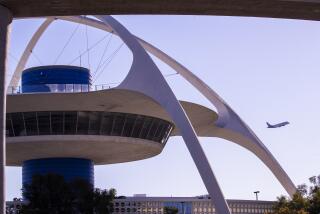Chopper, Plane in Near Miss by LAX
A small airliner coming in for a landing at Los Angeles International Airport early Friday narrowly missed a helicopter flying about 1,200 feet over the city near La Tijera Boulevard and the 405 Freeway, officials said.
An alarm sounded in the cockpit of American Eagle Flight 3034 from Santa Barbara, warning the pilot that he was too close to the helicopter and prompting him to abruptly pull up, said Dave Jackson, a spokesman for American Eagle. Twenty-six passengers and three crew members were on board.
The Saab turboprop came within 100 feet vertically of the helicopter and about a quarter of a mile horizontally, said Ian Gregor, a spokesman with the Federal Aviation Administration.
“This was really close,” Gregor said.
The FAA and American Eagle said they would investigate the incident.
This was the first near collision in the LAX area since Jan. 12, 2004, FAA records show. The agency labels an incident a near collision when airborne aircraft come within 500 vertical feet of each other.
The close call illustrates just how much traffic -- a mix of smaller airplanes, jumbo jets and helicopters -- plies the narrowly defined highways in the sky above the Los Angeles Basin. The San Diego air traffic control center that directs airplanes flying between about 2,000 feet and 13,000 feet in Southern California airspace handled more flights between January and June than any other facility in the country, according to the FAA.
In Friday’s incident, a controller cleared the American Eagle pilot to land on LAX’s northernmost runway about 6 a.m. Instead of making a routine approach from the Harbor Freeway, the pilot made a sharp turn, descended below 2,500 feet and headed for the airport, Gregor said. Jets typically fly above 2,500 feet in protected airspace around LAX. Smaller airplanes and helicopters routinely use airspace below this level.
A few seconds later, the pilot encountered the helicopter, which was chartered by KABC-TV Channel 7, officials said.
“Tower, this is 34,” the pilot radioed to controllers. “There’s a helicopter right off our wing.”
The pilot asked to abort his landing and go around the airport to come in for another try. After he landed on the second attempt, the pilot called the LAX tower and said his airplane had come so close to the helicopter that he could “see the whites of the helicopter pilot’s eyes,” controllers said.
“The controller that was working the airplane went home,” said Mike Foote, a controller in the LAX tower and the spokesman for the National Air Traffic Controllers Assn. “He came close to having a heart attack.”
Controllers said the American Eagle pilot should have told them that he planned to cut his approach short.
Officials said that even though it is standard procedure for pilots to seek permission from controllers to make the maneuver, the American Eagle pilot did not violate federal air regulations. He also was not prevented from descending below protected airspace around LAX, Gregor said.
The LAX controller who directed the American Eagle plane to land had just relieved another controller and was handling only two or three planes at the time, he said. The controller on the night shift had not entered the helicopter’s flight information into a computer so that his replacement could clearly identify it on the radar scope, Gregor said.
If the night-shift controller had done so, the radar system would probably have produced an audible alarm warning that the plane and the helicopter were too close together, Gregor said.
Controllers disputed Gregor’s description of the controller’s workload at the time of the incident, saying that he was handling half a dozen aircraft taxiing for takeoffs and coming in for landings on the airport’s three runways at the time.
Three controllers should have been on duty to handle the early morning rush, rather than the two who were in the tower Friday morning, Foote said, adding that understaffing may have contributed to the near miss.
“Staffing had nothing whatsoever to do with this, and any claim to the contrary is patently false,” Gregor said.
LAX officials said pilots who fly TV news helicopters near the airport are typically experienced and understand how crowded the airspace is and where they should and shouldn’t be.
“If this was indeed a TV news helicopter, it indeed is a very rare, and virtually unprecedented, incident,” said Paul Haney, deputy executive director of airports and security for the city agency that operates LAX.
Officials with Helinet Aviation, the owner of the helicopter, said they were unaware that there had been a near miss.
More to Read
Sign up for Essential California
The most important California stories and recommendations in your inbox every morning.
You may occasionally receive promotional content from the Los Angeles Times.










